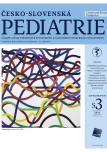-
Medical journals
- Career
Current perspectives on the aetiology of tall stature in children and adolescents (1): Syndromes associated with tall stature
Authors: Adamovičová Kateřina; Plachý Lukáš; Lebl Jan; Koloušková Stanislava; Průhová Štěpánka
Authors‘ workplace: Pediatrická klinika, 2. lékařská fakulta Univerzity Karlovy a Fakultní nemocnice v Motole
Published in: Čes-slov Pediat 2022; 77 (Supplementum 3): 11-17.
Category: Comprehensive Report
doi: https://doi.org/10.55095/CSPediatrie2022/053Overview
Tall stature is defined as body height more than +2 standard deviations (SD) for age and sex. The aetiology of tall stature can be genetic or non-genetic. Syndromic tall stature belongs to the genetic causes - e.g. Marfan syndrome, Klinefelter syndrome, Beckwith - Wiedemann syndrome, Sotos syndrome, Simpson-Golabi-Behmel syndrome, Malan syndrome, Weaver syndrome, Proteus syndrome, as well as syndromes caused by gonosomic trisomy (47,XXX, 47,XYY) or fragile X syndrome and homocystinuria etc. The diagnostics of tall stature is based on clinical evaluation of the typical signs and molecular genetic examination.
Syndromologic tall stature can be associated with higher oncologic (eg. higher risk of nephroblastoma or hepatoblastoma) or cardiovascular risks. The particular risks are based on the specific genetic cause of tall stature. Tall patients should be examined in detail so that the concrete risks can be revealed in time.
Keywords:
tall stature – aetiology of tall stature – syndromes associated with tall stature
Sources
- Meazza C, Gertosio C, Giacchero R, et al. Tall stature: a difficult diagnosis? Ital J Pediatr 2017; 43(1): 66.
- Albuquerque E, Scalco RC, Jorge A. Management of endocrine disease: Diagnostic and therapeutic approach of tall stature. Eur J Endocrinol 2017; 176(6): 339–353.
- Leung AKC, Leung AAC, Hon KL. Tall stature in children. Adv Pediatr 2019; 66 : 161–176.
- Berglund A, Stochholm K, Gravholt CH. The epidemiology of sex chromosome abnormalities. Am J Med Genet 2020; 184(2): 202–215.
- Corredor B, Dattani M, Gertosio C, Bozzola M. Tall stature: a challenge for clinicians. Curr Pediatr Rev 2019; 15(1): 10–21.
- Lebl J, Al Taji E, Koloušková S, et al. Dětská endokrinologie a diabetologie. Praha: Galén 2016 : 112–114, 124–132.
- Sood B, Clemente Fuentes RW. Jacobs syndrome. In: StatPearls. StatPearls Publishing 2022. Accessed February 5, 2022.
- Loeys BL, Dietz HC, Braverman AC, et al. The revised Ghent nosology for the Marfan syndrome. J Med Genet 2010; 47(7): 476–485.
- MacCarrick G, Black JH, Bowdin S, et al. Loeys–Dietz syndrome: a primer for diagnosis and management. Genet Med 2014; 16(8): 576–587.
- Tunçbilek E, Alanay Y. Congenital contractural arachnodactyly (Beals syndrome). Orphanet J Rare Dis 2006; 1(1): 20.
- Edmondson AC, Kalish JM. Overgrowth syndromes. J Pediatr Genet 2015; 4(3): 136.
- Weinberg DN, Papillon-Cavanagh S, Chen H, et al. The histone mark H3K - 36me2 recruits DNMT3A and shapes the intergenic DNA methylation landscape. Nature 2019; 573(7773): 281–286.
- Sotos JF. Sotos syndrome 1 and 2. Pediatr Endocrinol Rev 2014; 12(1): 2–16.
- Lebl J, Plachý L, Bláhová K, et al. Nadměrný růst u dětí a dospělých: nový klinický pohled, nové geny, nové fenotypy. Čas lék čes 2017; (5): 233–241.
- Shuman C, Beckwith JB, Weksberg R. Beckwith-Wiedemann syndrome. In: Adam MP, Ardinger HH, Pagon RA, et al. (eds.). GeneReviews®. University of Washington: Seattle 1993. Accessed February 25, 2022.
- Plachy L, Elblova L, Neuman V, et al. For Debate: The significance of etiologic diagnosis in neonates with overgrowth syndromes. Lesson learned from the Simpson - Golabi - Behmel syndrome. 2018; (1): 1–7.
- Tenorio J, Arias P, Martínez-Glez V, et al. Simpson-Golabi-Behmel syndrome types I and II. Orphanet J Rare Dis 2014; 9 : 138.
- Hubmacher D, Sabatier L, Annis DS, et al. Homocysteine modifies structural and functional properties of fibronectin and interferes with the fibronectin-fibrillin-1 interaction. Biochemistry 2011; 50(23): 5322 – 5332.
- S equerra Amram Cohen A, Gibson WT. EED-related overgrowth. In: Adam MP, Ardinger HH, Pagon RA, et al. (eds.). GeneReviews®. University of Washington, Seattle 1993. Accessed February 25, 2022.
- Kenis V, Melchenko E, Mazunin I, et al. A new family with epiphyseal chondrodysplasia type Miura. Am J Med Genet A 2021; 185(1): 112–118.
Labels
Neonatology Paediatrics General practitioner for children and adolescents
Article was published inCzech-Slovak Pediatrics

2022 Issue Supplementum 3-
All articles in this issue
- Vážení kolegové, přátelé, pediatři z primární péče, z regionálních nemocnic i z klinik,
- Minipuberty – an important and still neglected period of sexual development
- Current perspectives on the aetiology of tall stature in children and adolescents (1): Syndromes associated with tall stature
- Current perspectives on the aetiology of tall stature in children and adolescents (2): Non-syndromic tall stature
- Endocrine causes of obesity in childhood and adolescence
- Children and adolescents with gender incongruence: current approaches and situation in the Czech Republic
- First experience with long-acting growth hormone
- Mystický Hagibor a jeho místo v historii české pediatrie
- Czech-Slovak Pediatrics
- Journal archive
- Current issue
- Online only
- About the journal
Most read in this issue- Minipuberty – an important and still neglected period of sexual development
- First experience with long-acting growth hormone
- Current perspectives on the aetiology of tall stature in children and adolescents (1): Syndromes associated with tall stature
- Children and adolescents with gender incongruence: current approaches and situation in the Czech Republic
Login#ADS_BOTTOM_SCRIPTS#Forgotten passwordEnter the email address that you registered with. We will send you instructions on how to set a new password.
- Career

